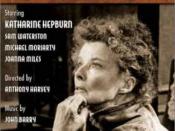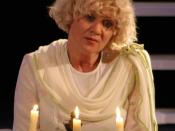Williams uses the unconventional structures that can be applied to his memory play 'The Glass Menagerie' to great effect. Him allowing the actors to simulate actions like eating helps the audience recognise that the play is not realistic and maybe somewhat changed in Tom's mind. The play itself is split up into a few small scenes which are all set around the same area. The scenes of the play are actually almost episodes of a whole story. Each episode in the play has a series of key points which the audience need to recognise so that they can all be sewn together and the play then fully understood. To make sure the audience picks up on these points Williams uses projected images and phrases on a screen on the set. Being an episodic play the visible set needs minimal changes. The music that is played helps the audience to focus on particular areas because, at times of extreme tension, joy and another powerful emotion music is played.
The lighting in the play is also unrealistic and helps direct the audience's focus on certain aspects on the set which would not necessarily be the focus of the audience.
At the time of writing the inclusion of slides projected onto a screen in a theatrical production was a revolutionary idea. Each episode of the play has a series of key points and all of these are vital to understanding the whole play. Therefore, to try and make sure that all these points are picked up on Williams suggested the use of the projected legends or pictures. When they are projected they are shown, according to Williams in his production notes, 'to give accent to certain values in each scene'. This is especially evident at the start of Scene Three when...


